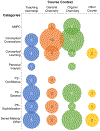Through the Looking CLASS: When Peer Leader Learning Attitudes Are Not What They Seem
- PMID: 32952212
- PMCID: PMC7494070
- DOI: 10.1021/acs.jchemed.0c00129
Through the Looking CLASS: When Peer Leader Learning Attitudes Are Not What They Seem
Abstract
The Teaching Internship is a credit-bearing program comprised of undergraduate near peer instructors (Teaching Interns, or TIs) that offers supplemental assistance for students in the General Chemistry courses. With fellow undergraduates serving as a role model and student-faculty liaison, the benefits of near peer instruction have been well-documented. Because TIs develop a dual role of student and instructor over time, they afford a unique opportunity to explore the middle area of the expert/novice spectrum. Identifying the most influential components of the TI role may allow practitioners to implement these components in other ways for different groups of students. The present work provides a description of the TI model and uses a mixed-methods approach to analyze how the peer leadership role impacted the TIs' attitudes about learning chemistry. Quantitative results show that TIs do hold predominantly expert-like learning attitudes compared to the General Chemistry population from which they are selected; however, evidence of novice thinking is still observed in some areas. This survey data was then used to inform a qualitative approach. Further analysis indicated that TIs' responses on survey items were context-dependent, and that peer leadership experiences were associated with expert learning attitudes and appear to be influential in the development of these attitudes. These findings suggest that these factors should be taken into account when drawing general conclusions from survey results.
Keywords: Chemical Education Research; Collaborative/Cooperative Learning; Constructivism; First-Year Undergraduate/General; Student-Centered Learning; TA Training/Orientation.
Figures





Similar articles
-
Feasibility and outcomes of paid undergraduate student nurse positions.Nurs Leadersh (Tor Ont). 2006 Sep;19(3):e1-14. doi: 10.12927/cjnl.2006.19032. Nurs Leadersh (Tor Ont). 2006. PMID: 19830923
-
Teacher Knowledge for Active-Learning Instruction: Expert-Novice Comparison Reveals Differences.CBE Life Sci Educ. 2018 Spring;17(1):ar12. doi: 10.1187/cbe.17-07-0149. CBE Life Sci Educ. 2018. PMID: 29420184 Free PMC article.
-
The "Near-Peer" Approach to Teaching Musculoskeletal Physical Examination Skills Benefits Residents and Medical Students.PM R. 2017 Mar;9(3):251-257. doi: 10.1016/j.pmrj.2016.06.004. Epub 2016 Jun 10. PM R. 2017. PMID: 27292435
-
A novel 6D-approach to radically transform undergraduate medical education: preliminary reflections from MBRU.BMC Med Educ. 2018 Dec 12;18(1):304. doi: 10.1186/s12909-018-1402-0. BMC Med Educ. 2018. PMID: 30541527 Free PMC article. Review.
-
Peer-led training and assessment in basic life support for healthcare students: synthesis of literature review and fifteen years practical experience.Resuscitation. 2012 Jul;83(7):894-9. doi: 10.1016/j.resuscitation.2012.01.013. Epub 2012 Jan 26. Resuscitation. 2012. PMID: 22285723 Review.
Cited by
-
Inquiry-Based Activities and Games That Engage Students in Learning Atomic Orbitals.J Chem Educ. 2022 May 10;99(5):2175-2181. doi: 10.1021/acs.jchemed.1c01023. Epub 2022 Mar 15. J Chem Educ. 2022. PMID: 35645409 Free PMC article.
References
-
- National Science Board. 2018. Science and Engineering Indicators 2018. NSB-2018-1. Alexandria, VA: National Science Foundation; Retrieved from at https://www.nsf.gov/statistics/indicators/ (accessed 08/19/19).
-
- Two Decades of Change in Federal and State Higher Education Funding; The Pew Research Center: October 2019.
-
- Arendale DR, History of supplemental instruction (SI): Mainstreaming of developmental education In Histories of Developmental Education, Lundell DB; Higbee JL, Eds. Center for Research on Developmental Education and Urban Literacy, General College, University of Minnesota: Minneapolis, MN, 2002; pp 15–27.
-
- Herrman JW; Waterhouse JK, Benefits of using undergraduate teaching assistants throughout a baccalaureate nursing curriculum. Journal of Nursing Education 2010, 49 (2), 72–77. - PubMed
Grants and funding
LinkOut - more resources
Full Text Sources
